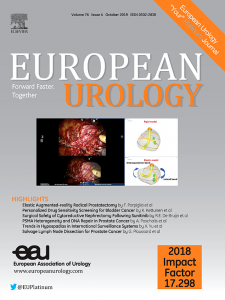如何解释前瞻性随机临床试验的亚组分析:临床医生需要知道什么
IF 25.2
1区 医学
Q1 UROLOGY & NEPHROLOGY
引用次数: 0
摘要
大多数随机对照试验的设计是为了测试整体治疗效果,而不是为了检测亚组的效果。随着每增加一个亚组比较,假阳性结果的可能性增加。例如,测试5个独立的子组,有23%的机会单独观察到至少一个p值<;0.05,如果有10个独立的子组,这一概率上升到40%(图1A)。此外,在至少一个亚组中看到治疗效果逆转的可能性令人惊讶。证据水平和荟萃分析的作用。亚组声明的可信度取决于研究设计和背景。预先指定的分析具有足够的功率,显著的相互作用测试和生物学原理比事后发现更重要(图2A)。在CHAARTED试验中,预先指定的亚组分析显示,患有高疾病体积转移性激素敏感前列腺癌(mHSPC)的男性,雄激素剥夺治疗(ADT) +多西他赛的OS比单独使用ADT的OS更长(风险比0.60,95%)。传统的亚组定义与数据驱动的亚组定义传统上依赖于临床判断和生物学原理,如根据肿瘤分期、生物标志物表达或既往治疗对患者进行分类。这些分类以现有知识为基础,更容易解释和交流。然而,他们可能忽略了治疗异质性的更复杂的预测因素。相比之下,数据驱动的方法,如递归分区、聚类和机器学习算法可以发现未被识别的结论。除非在设计阶段预先规定了这种分析,否则任何发现都应被视为探索性的,并在未来的试验中得到证实(图2B)。设计不佳的亚组分析有误导解释的风险,并可能侵蚀临床医生、监管机构和公众之间的信任。可信的子组声明需要预先说明、足够的权力、正式的交互测试和元分析等保障措施。统计报告应本文章由计算机程序翻译,如有差异,请以英文原文为准。
How To Interpret Subgroup Analyses from Prospective Randomized Clinical Trials: What Clinicians Need To Know
Section snippets
Inflated type I errors
Most RCTs are designed to test the overall treatment effect and not for detection of effects in subgroups. With each additional subgroup comparison, the likelihood of a false-positive result increases. For example, testing five independent subgroups yields a 23% chance of observing at least one p value <0.05 by chance alone, which rises to 40% with ten independent subgroups (Fig. 1A). Moreover, the probability of seeing a reversal of a treatment effect in at least one subgroup is surprisinglyLevels of evidence and the role of meta-analysis
The credibility of a subgroup claim depends on the study design and context. Prespecified analyses with adequate power, significant interaction tests, and a biological rationale carry more weight than post hoc findings (Fig. 2A). In the CHAARTED trial, a prespecified subgroup analysis showed that men with high-disease volume metastatic hormone-sensitive prostate cancer (mHSPC) had longer OS with androgen deprivation therapy (ADT) + docetaxel than with ADT alone (hazard ratio 0.60, 95%Traditional versus data-driven subgroup definitions
Subgroup definitions have traditionally relied on clinical judgment and biological rationale, such as classification of patients by tumor stage, biomarker expression, or prior treatments. These categories are grounded in existing knowledge and are easier to interpret and communicate. However, they may overlook more complex predictors of treatment heterogeneity.By contrast, data-driven methods such as recursive partitioning, clustering, and machine-learning algorithms can uncover unrecognizedConclusions
Subgroup analyses must be approached with caution. Unless such analyses are prespecified at the design stage, any findings should be considered exploratory and confirmed in future trials (Fig. 2B). Poorly designed subgroup analyses risk misleading interpretation and may erode trust among clinicians, regulators, and the public. Credible subgroup claims require safeguards such as prespecification, adequate power, formal interaction testing, and meta-analysis. Statistical reporting should求助全文
通过发布文献求助,成功后即可免费获取论文全文。
去求助
来源期刊

European urology
医学-泌尿学与肾脏学
CiteScore
43.00
自引率
2.60%
发文量
1753
审稿时长
23 days
期刊介绍:
European Urology is a peer-reviewed journal that publishes original articles and reviews on a broad spectrum of urological issues. Covering topics such as oncology, impotence, infertility, pediatrics, lithiasis and endourology, the journal also highlights recent advances in techniques, instrumentation, surgery, and pediatric urology. This comprehensive approach provides readers with an in-depth guide to international developments in urology.
 求助内容:
求助内容: 应助结果提醒方式:
应助结果提醒方式:


